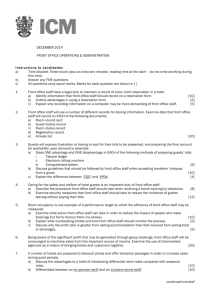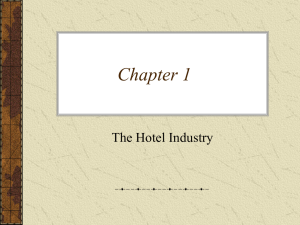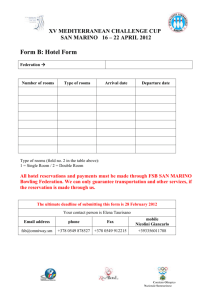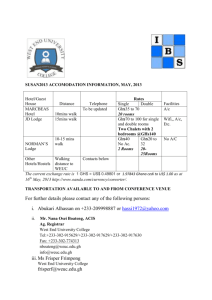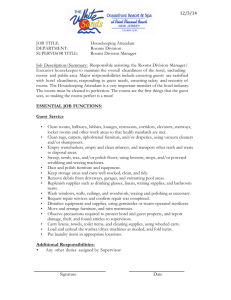unit - v - E
advertisement
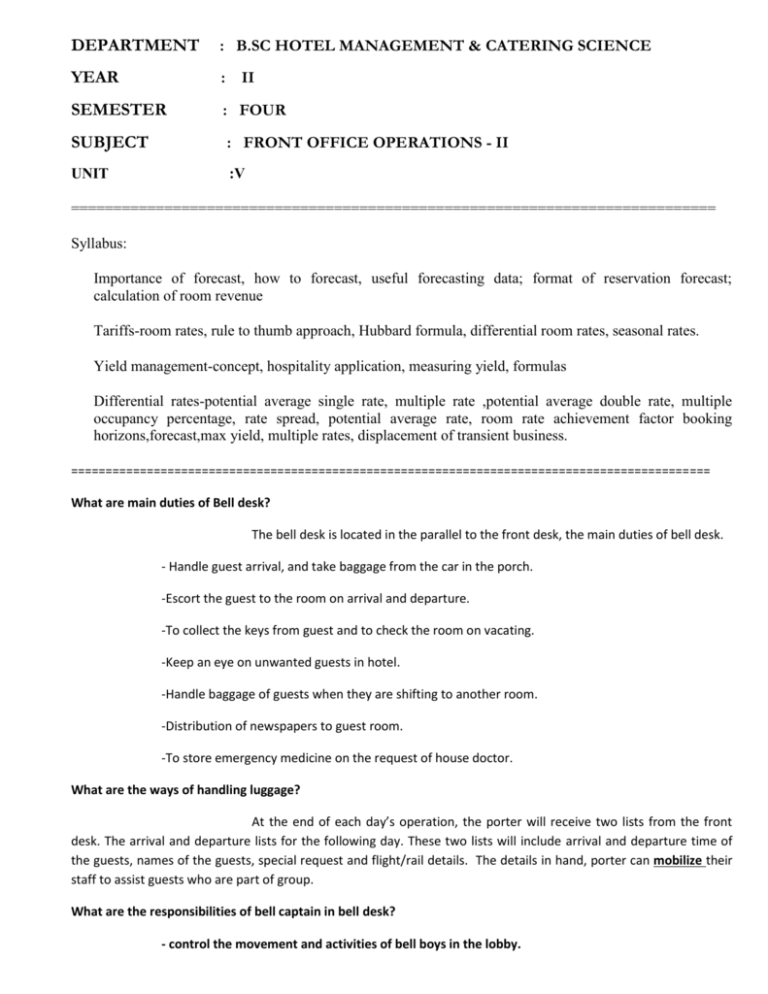
DEPARTMENT : B.SC HOTEL MANAGEMENT & CATERING SCIENCE YEAR : SEMESTER : FOUR SUBJECT : FRONT OFFICE OPERATIONS - II UNIT :V II ============================================================================ Syllabus: Importance of forecast, how to forecast, useful forecasting data; format of reservation forecast; calculation of room revenue Tariffs-room rates, rule to thumb approach, Hubbard formula, differential room rates, seasonal rates. Yield management-concept, hospitality application, measuring yield, formulas Differential rates-potential average single rate, multiple rate ,potential average double rate, multiple occupancy percentage, rate spread, potential average rate, room rate achievement factor booking horizons,forecast,max yield, multiple rates, displacement of transient business. ============================================================================================= What are main duties of Bell desk? The bell desk is located in the parallel to the front desk, the main duties of bell desk. - Handle guest arrival, and take baggage from the car in the porch. -Escort the guest to the room on arrival and departure. -To collect the keys from guest and to check the room on vacating. -Keep an eye on unwanted guests in hotel. -Handle baggage of guests when they are shifting to another room. -Distribution of newspapers to guest room. -To store emergency medicine on the request of house doctor. What are the ways of handling luggage? At the end of each day’s operation, the porter will receive two lists from the front desk. The arrival and departure lists for the following day. These two lists will include arrival and departure time of the guests, names of the guests, special request and flight/rail details. The details in hand, porter can mobilize their staff to assist guests who are part of group. What are the responsibilities of bell captain in bell desk? - control the movement and activities of bell boys in the lobby. -Attend the guest complaints and handle telephone call in the absence o assistance manager. or lobby - check the sale of postage stamps and stationery to guest. -Maintain record of guest with scanty baggage and inform to senior manager in lobby. -Conduct daily briefing to lobby attendees -Co-ordinate and control the distribution of morning news papers in time. Forecasting: The meaning of forecasting is Calculating beforehand. Importance of forecast: How to forecast: A thorough knowledge of the hotel and its surrounding area. Market profiles of other hotels. Occupancy data for the past several months of previous year. Reservation trends and a history lead times. A listing of special events scheduled in the surroundings. Business profiles of specific groups booked for the forecast dates. The number of non guaranteed and guaranteed reservations and an estimate of the number of expected no shows. The percentage of rooms already reserved and the cut off date for room blocks held for the forecast dates. Renovating the hotel that would change the number of available rooms Useful forecasting data: Number of expected room arrivals. Number of expected room walk inns. No of expected room stay overs . No of expected room no shows. No of expected room understays No of expected room checkouts. No of expected room overstays. Forecast formula: Total no of guestrooms (-) No of out of order rooms(-)no of room stayovers(-)no of room reservations(+)no of room reservations (x) percentage of no shows(+)no of room understays(-)no of room overstays (=) number of rooms available for sale. Calculation of forecasted rooms revenue=Rooms available x occupancy percentage x Average daily rate. Tariffs: Establishing room rates: They will always have one room rate category for each of its guestrooms. It categories with its Types of rooms. Rate difference are based on room size, location, view, furnishings, and amenities. Each room rate is categorized and assigned rack rate based on the occupancy. The rack rate is the standard price determined by front office management. The front office manager should examine the circumstance under special rates are granted to ensure that f.o staff are adhering to prescribed policies. All policies should be clearly explained to front officestaff, who should obtain proper approval when applying a special room rate. Room rates often serve as a market positioning statement since they directly reflect service expectations to the hotels target market. Room rate positioning can be critical to a hotels target market. Room rate positioning can be critical to a hotels success. Different types of rate are, 1. Corporate or commercial rate:The rate offered to companies that provide frequent business for the hotel or its chain. 2. Group rate: The rate offered to groups , meetings, and conventions using the hotel for their functions. 3. Promotional rate: The rate offered to individuals who may belong to an affinity group such as American automobile associations. The rate may also be extended during special low occupancy periods to any guest to promote occupancy. 4. Incentive rate: The rate offered tp guests in affiliated organizations such as travel agencies and airlines because of potential referral business. The rate may also be offered to promote future business; it is often extended to group leaders, operators. 5. Family rate: A rate reserved for families with children. 6. Package plan rate: A rate that includes a guestroom in combination with other events or activities. 7. Complimentary rate: a room rate provided to special guests and or important industry leaders. Rule of thumb approach: A rule for general guidance, based on experience or practice rather than theory. The rule of thumb approach sets the rate of a room at $1 for each $1000 of construction and furnishings cost per room assuming a 70 percent occupancy. The rule of thumb approach to pricing rooms also fails to consider the contribution of other facilities and services toward the hotels desired profitability. In many hotels guest pay for their services. If these services contribute to profitability the hotel may have less pressure to charge higher room rates. If the lower percentage of occupancy is expected , the hotel will have to capture a higher average rate to generate the same amount of room revenue. hotels tend to have a very high level of fixed expenses. The f.o mgr must understand the effects of room rate and room occupancy on room revenue to ensure that the hotel meets its revenue goals and financial oblications. Hubbart Formula approach: A more recently developed approach to average room rate determination is the hubbart formula. To determine the average selling price per room , this approach considers operating costs, desired profits and expected number of rooms sold. In other profits this approach starts with the desired profit , adds fixed charges and management fees, followed by operating overhead expenses and direct operating expenses. The hubbart formula approach involves the following eight steps. Calculate the hotels desired profit by multiplying the desired rate of return (ROI) by the owners investment. Calculate pretax profits by dividing desired profit step1 by minus 1 the hotels tax rate. Calculate fixed charges and management fees. This calculation includes estimating depreciation , interest expense, property taxes, insurance, amortization, building mortgage , land, rent, and management fees. Calculate undistributed operating expenses. This calculation includes estimating administrative and general data processing, human resources, transportation, marketing , property operation and maintenance, energy costs. Estimate non room operated department income or loss, that is food and beverage & telephone department income or loss. Calculate the required rooms department income. The sum of pretax profits step2, fixed charge & management fees step3,undistributed expenses step4, and other operated department loses less other operated department income step5, equals the required rooms department income. The hubbart formula in essence places the overall financial burden of the hotel on the rooms department. Determine the rooms department revenue. The required rooms department income step6, plus rooms department direct expenses of payroll and related expenses, plus other direct operating expenses , equals the required rooms department revenue. Calculate the average room rate by dividing rooms department revenue step7 by the expected number of rooms to be sold. Yield management: It presents a more precise measure of performance because it combines occupancy percentage and ADR(average daily rate) into a single statistic .Revenue management is a technique used to maximize room revenues. Concept of yield management: Yield management has proven successful in the lodging and other things in situations where reservations are taken for a perishable commodity. The key to successful implementation appears to be an ability to monitor reservations and to develop reliable forecasts. Revenue management is based on supply and demand. Prices tend to rise when demand exceeds supply: conversely, prices tend to fall when supply exceeds demand. Proper pricing adjustments which take existing demand into account and can even influence it, appear to be the key to profitability. To increase revenue, the hotel industry is attempting to develop new forecasting techniques that will enable it to respond to changes in supply and demand with optimal room rates. The hotel industry focuss is shifting from high volume bookings to high profit bookings. By increasing bookings on low demand days and by selling rooms at higher room rates on high demand days the industry improves its profitability. Room rates should be higher when demand exceeds supply and lower when supply exceeds demand. Hospitality applications: All perisable products that cannot be stored if unsold by a specific time. The commodity that hotels sell is time in a given space. If a room is not sold for that night we can not recover the lost so typically sold for varying prices that depend on the timing of the transaction and the proposed date of delivery. So f.o .mgr have identified several benefits including. Improved forecasting. Improved seasonal pricing and inventory decisions. Identification of new market segments. Identification of market segment demands. Enhanced coordination between the front office and sales divisions. Determination of discounting activity. Improved development of business plans. Establishment of a value based rate structure. Initiation of consistent customer contact scripting /requests regarding reservations. Yield management seeks to maximize revenue by controlling forecast information in 3 ways capacity mgt, discount allocation, and duration control. Measuring Yield: Revenue management is designed to measure revenue achievement. One of the principal computations involved in revenue management is the hotels yield statistic. The yield statistic is the ratio of actual revenue to potential revenue. Actual revenue is the revenue generated by the number of rooms sold potential revenue is the amount of money that would be received if all rooms were sold at their rack rates. Differential rates: Potential Average single rate=single room revenues at rack rate/number of rooms sold as singles Potential Average double rate=Double room revenues at rack rate/number of rooms sold as doubles Multiple occupancy rate=total no. of rooms sold/no. of rooms available Rate spread= potential average double rate-potential average single rate Potential average rate= (multiple occupancy % x rate spread)+potential average sgl rate Room rate achievement factor= actual average rate/potential average rate. Booking horizons (booking lead time):Booking lead time measures how far in advance of a stay bookings are made. Many hotels group bookings are usually made within one year of planned arrival. Management should determine its hotels lead time for group bookings If the current booking is lower than expected or lags behind the historical trend, it may be necessary to offer a lower room rate to stimulate increased occupancy. On the other hand if demand is strong and the group booking pace is ahead of historical trends, it may not be appropriate to discount room rates. Displacement of transient business: management should consult its demand forecast when determining whether or not to accept additional group business. Displacement occurs when a hotel accepts group business at the expense of transient guests. Since transient guests often pay higher room rates than group members, this situation warrands close scrutiny. Transient rooms are guestroom sold to guests who are not affiliated with a group registered with the hotl. These guests are called FIT.



